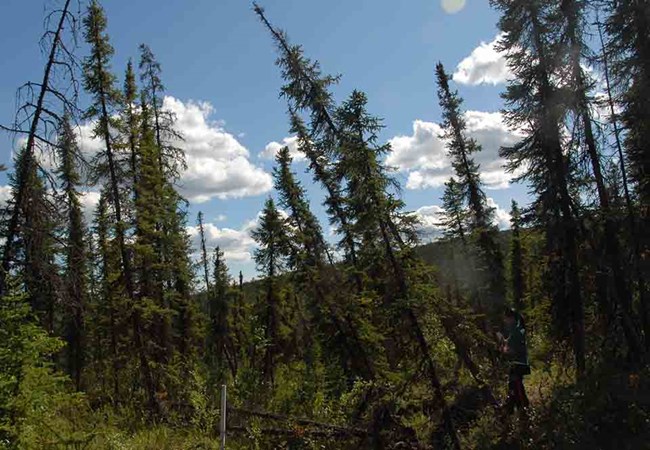Last updated: December 30, 2019
Article
Permafrost Thaw in Boreal Ecosystems

DOM composition and transformation in boreal forest soils: The effects of temperature and organic‐horizon decomposition state
Abstract
The boreal region stores large amounts of organic carbon (C) in organic‐soil horizons, which are vulnerable to destabilization via warming and disturbance. Decomposition of soil organic matter (SOM) contributes to the production and turnover of dissolved organic matter (DOM). While temperature is a primary control on rates of SOM and DOM cycling, little is known about temperature effects on DOM composition in soil leachate. Here we conducted a 30 day incubation to examine the effects of temperature (20 versus 5°C) and SOM decomposition state (moss versus fibric versus amorphous horizons) on DOM composition in organic soils of interior Alaska. We characterized DOM using bulk dissolved organic C (DOC) concentration, chemical fractionation, optical properties, and ultrahigh‐resolution mass spectrometry. We observed an increase in DOC concentration and DOM aromaticity in the 20°C treatment compared to the 5°C treatment. Leachate from fibric horizons had higher DOC concentration than shallow moss or deep amorphous horizons. We also observed chemical shifts in DOM leachate over time, including increases in hydrophobic organic acids, polyphenols, and condensed aromatics and decreases in low‐molecular weight hydrophilic compounds and aliphatics. We compared ultrahigh‐resolution mass spectrometry and optical data and observed strong correlations between polyphenols, condensed aromatics, SUVA254, and humic‐like fluorescence intensities. These findings suggest that biolabile DOM was preferentially mineralized, and the magnitude of this transformation was determined by kinetics (i.e., temperature) and substrate quality (i.e., soil horizon). With future warming, our findings indicate that organic soils may release higher concentrations of aromatic DOM to aquatic ecosystems.
O’Donnell, J. A., G. R. Aiken, K. D. Butler, F. Guillemette, D. C. Podgorski, and R. G. M. Spencer. 2016. DOM composition and transformation in boreal forest soils: The effects of temperature and organic-horizon decomposition state. Journal of Geophysical Research: Biogeosciences 121. doi:10.1002/ 2016JG003431
Rapid carbon loss and slow recovery following permafrost thaw in boreal peatlands
Abstract
Permafrost peatlands store one-third of the total carbon (C) in the atmosphere and are increasingly vulnerable to thaw as high-latitude temperatures warm. Large uncertainties remain about C dynamics following permafrost thaw in boreal peatlands. We used a chronosequence approach to measure C stocks in forested permafrost plateaus (forest) and thawed permafrost bogs, ranging in thaw age from young (<10 years) to old (>100 years) from two interior Alaska chronosequences. Permafrost originally aggraded simultaneously with peat accumulation (syngenetic permafrost) at both sites. We found that upon thaw, C loss of the forest peat C is equivalent to ~30% of the initial forest C stock and is directly proportional to the prethaw C stocks. Our model results indicate that permafrost thaw turned these peatlands into net C sources to the atmosphere for a decade following thaw, after which post-thaw bog peat accumulation returned sites to net C sinks. It can take multiple centuries to millennia for a site to recover its prethaw C stocks; the amount of time needed for them to regain their prethaw C stocks is governed by the amount of C that accumulated prior to thaw. Consequently, these findings show that older peatlands will take longer to recover prethaw C stocks, whereas younger peatlands will exceed prethaw stocks in a matter of centuries. We conclude that the loss of sporadic and discontinuous permafrost by 2100 could result in a loss of up to 24 Pg of deep C from permafrost peatlands.
Jones, M. C., J. Harden, J. O’Donnell, K. Manies, T. Jorgenson, C. Treat, and S. Ewing. 2016. Rapid carbon loss and slow recovery following permafrost thaw in boreal peatlands. Global Change Biology doi: 10.1111/gcb.13403
